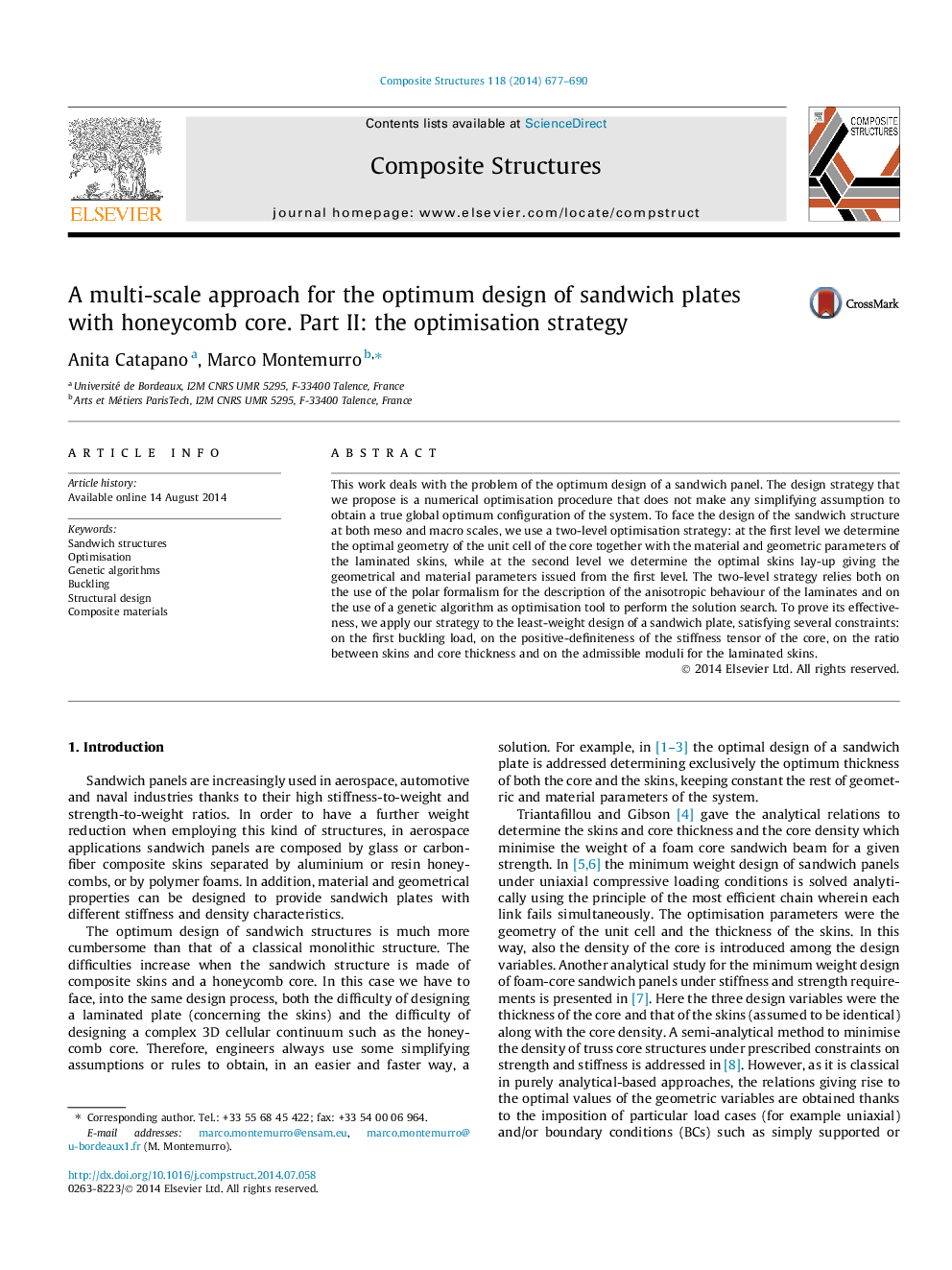| کد مقاله | کد نشریه | سال انتشار | مقاله انگلیسی | نسخه تمام متن |
|---|---|---|---|---|
| 6707727 | 502935 | 2014 | 14 صفحه PDF | دانلود رایگان |
عنوان انگلیسی مقاله ISI
A multi-scale approach for the optimum design of sandwich plates with honeycomb core. Part II: the optimisation strategy
ترجمه فارسی عنوان
یک روش چند بعدی برای طراحی بهینه صفحات ساندویچ با هسته لانه زنبوری. قسمت دوم: استراتژی بهینه سازی
دانلود مقاله + سفارش ترجمه
دانلود مقاله ISI انگلیسی
رایگان برای ایرانیان
کلمات کلیدی
سازه های ساندویچ، بهینه سازی، الگوریتم ژنتیک، خم شدن طراحی سازه، مواد کامپوزیتی،
ترجمه چکیده
این کار با مشکل طراحی بهینه یک پانل ساندویچ روبرو است. استراتژی طراحی که ما پیشنهاد می دهیم، یک روش بهینه سازی عددی است که هیچ فرض ساده ای برای به دست آوردن یک پیکربندی بهینه مطلوب جهانی در سیستم ایجاد نمی کند. برای مقابله با طراحی ساختار ساندویچ در هر دو مقیاس و مقیاس ما از استراتژی بهینه سازی دو سطح استفاده می کنیم: در سطح اول ما هندسه بهینه از سلول واحد هسته همراه با پارامترهای مواد و هندسی لایه لایه پوسته ها، در حالی که در سطح دوم، پوسته های بهینه را تعیین می کنیم که پارامترهای هندسی و مواد را از سطح اول صادر می کنند. استراتژی دو سطح به هر دو در استفاده از فرمالیتم قطبی برای توصیف رفتار ناهمسانگردی ورقه ورقه ها و استفاده از الگوریتم ژنتیکی به عنوان ابزار بهینه سازی برای انجام جستجوی راه حل متکی است. برای اثبات اثربخشی آن، استراتژی ما را در طراحی کمترین وزن یک صفحه ساندویچ اعمال می کنیم، که رفع چندین محدودیت می شود: بر روی بار اول بارگذاری، در قطعیت مثبت تانسور سفتی هسته، در رابطه بین پوسته ها و هسته ضخامت و ماژول قابل قبول برای پوسته های چند لایه.
موضوعات مرتبط
مهندسی و علوم پایه
سایر رشته های مهندسی
مهندسی عمران و سازه
چکیده انگلیسی
This work deals with the problem of the optimum design of a sandwich panel. The design strategy that we propose is a numerical optimisation procedure that does not make any simplifying assumption to obtain a true global optimum configuration of the system. To face the design of the sandwich structure at both meso and macro scales, we use a two-level optimisation strategy: at the first level we determine the optimal geometry of the unit cell of the core together with the material and geometric parameters of the laminated skins, while at the second level we determine the optimal skins lay-up giving the geometrical and material parameters issued from the first level. The two-level strategy relies both on the use of the polar formalism for the description of the anisotropic behaviour of the laminates and on the use of a genetic algorithm as optimisation tool to perform the solution search. To prove its effectiveness, we apply our strategy to the least-weight design of a sandwich plate, satisfying several constraints: on the first buckling load, on the positive-definiteness of the stiffness tensor of the core, on the ratio between skins and core thickness and on the admissible moduli for the laminated skins.
ناشر
Database: Elsevier - ScienceDirect (ساینس دایرکت)
Journal: Composite Structures - Volume 118, December 2014, Pages 677-690
Journal: Composite Structures - Volume 118, December 2014, Pages 677-690
نویسندگان
Anita Catapano, Marco Montemurro,
